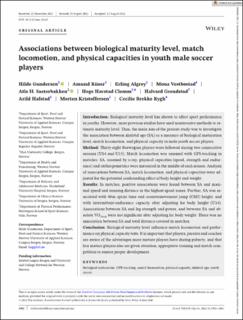Associations between biological maturity level, match locomotion, and physical capacities in youth male soccer players
Gundersen, Hilde; Riiser, Amund; Algrøy, Erling Andre; Vestbøstad, Mona; Sæterbakken, Atle Hole; Clemm, Hege Synnøve Havstad; Grendstad, Halvard; Hafstad, Arild; Kristoffersen, Morten; Rygh, Cecilie Brekke
Peer reviewed, Journal article
Published version
Permanent lenke
https://hdl.handle.net/11250/3031303Utgivelsesdato
2022Metadata
Vis full innførselSamlinger
- Publikasjoner fra CRIStin [111]
- Tidsskriftartikler [94]
Sammendrag
Introduction: Biological maturity level has shown to affect sport performance in youths. However, most previous studies have used noninvasive methods to estimate maturity level. Thus, the main aim of the present study was to investigate the association between skeletal age (SA) as a measure of biological maturation level, match locomotion, and physical capacity in male youth soccer players. Method: Thirty-eight Norwegian players were followed during two consecutive seasons (U14 and U15). Match locomotion was assessed with GPS-tracking in matches. SA, assessed by x-ray, physical capacities (speed, strength and endurance) and anthropometrics were measured in the middle of each season. Analysis of associations between SA, match locomotion, and physical capacities were adjusted for the potential confounding effect of body height and weight. Results: In matches, positive associations were found between SA and maximal speed and running distance in the highest speed zones. Further, SA was associated with 40 m sprint time and countermovement jump (CMJ) height, and with intermittent-endurance capacity after adjusting for body height (U14). Associations between SA and leg strength and power, and between SA and absolute VO2max were not significant after adjusting for body weight. There was no association between SA and total distance covered in matches. Conclusion: Biological maturity level influence match locomotion and performance on physical capacity tests. It is important that players, parents and coaches are aware of the advantages more mature players have during puberty, and that less mature players also are given attention, appropriate training and match competition to ensure proper development.

